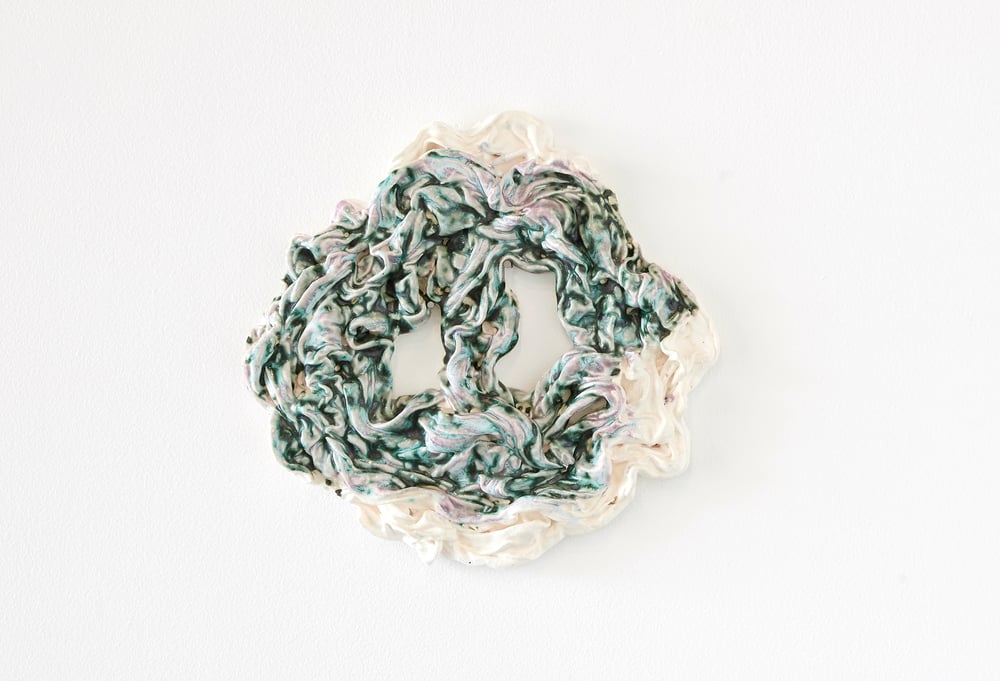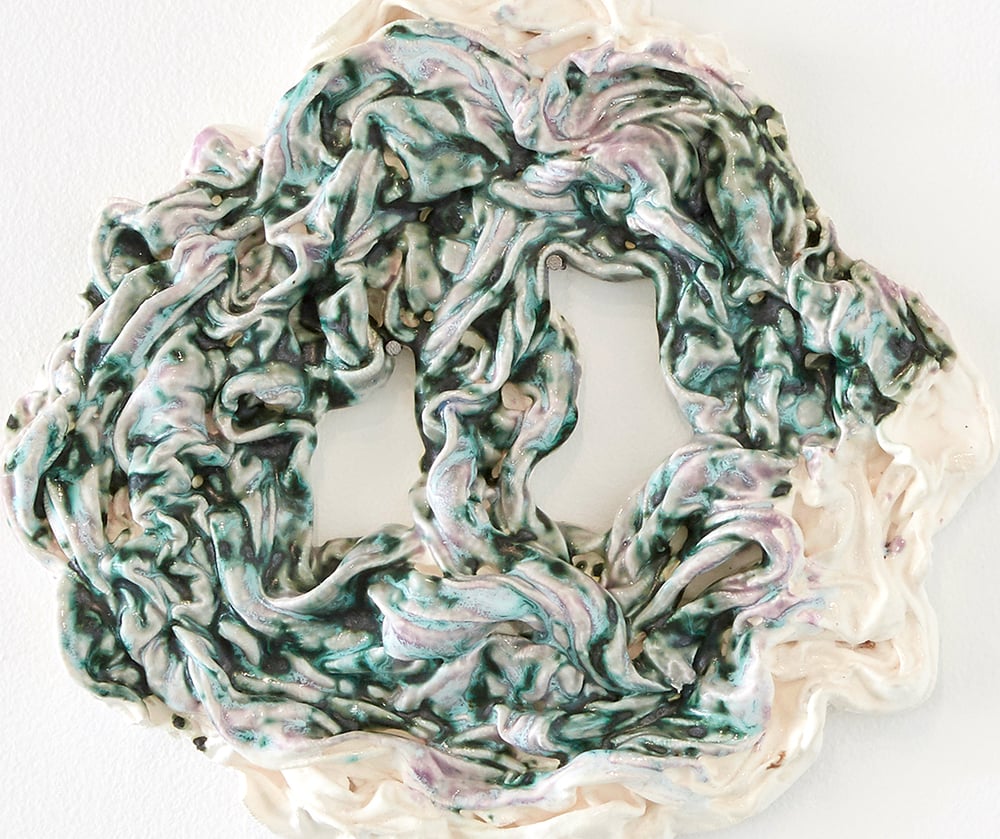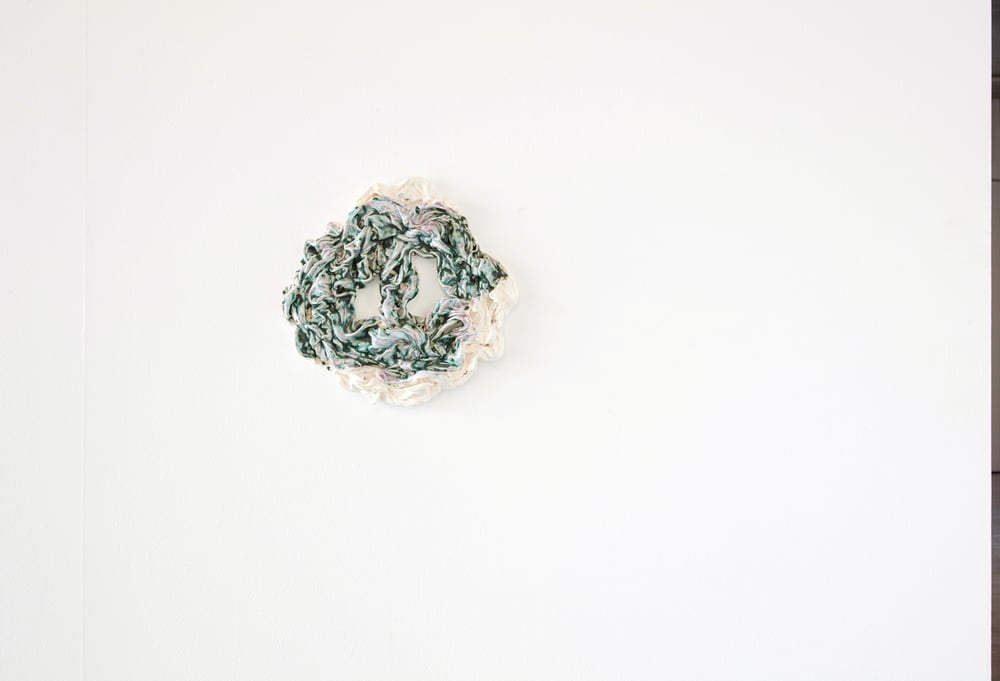



Artist: Jana Hawkins-Andersen
Title: Green Man I
Date: 2021
Size: 30 x 30 x 5 cm
Material: Textile formed glazed earthenware
Payment plans are very welcome please enquire!
If you want to covid safe pick up the work in Sydney pls enter PICKUP when checking out.
Installation note: the work is ready to hang on the wall using nails.
Extract from:
JANA HAWKINS-ANDERSEN
interviewed by AINSLIE TEMPLETON
for Suite 7a / March 2022
'The kiln blessed me' I remember this comment ringing in one of Jana Hawkins-Andersen's Instagram stories depicting her work, a particularly beautiful and slug-like shroud harvested from the oven. The artist's delicate ceramics are a diligent negotiation with layers of clay and glaze, temperamental textiles and the technology of fire. With a recent show, 'Steel Magnolias', at Verge Gallery in Sydney (feat. a text by me), and a finalist in the SCA's Fauvette Loureiro Memorial Scholarship this year, Hawkins-Andersen has been steadily producing despite the dampening impact of the pandemic, and now has a series of works available through Suite 7a. Here we discuss her treatment of materials, neoclassical grottos, dirty laundry and the legacy of her great grandmother, famed abstract-modernist sculptor Margel Hinder.
AT: I wanted to start with absorbency. I have some of your work in my apartment and I look at it up close all the time. It's like the pieces you have at Suite 7a, one of these post-textiles that is fabric rendered in clay. It looks sort of like a rag pushed into a corner, you can even see the little ribbings in the material. The glaze is spam pink and green, sitting on top of it in a shell, and the underside is left white and chalky. It looks so wet but there is this refusal to coalesce and become a single thing. It's not actually sinking in.
JHA: That's obviously really important to what it is in its structural component. It's always about materials absorbing each other. The work is very materially focused, and that's a starting point for me. Those works are made using a process called ‘burning out’, where fabric is dipped in clay and then fired in the kiln. During the firing process the fabric burns away and you are left with this hard shell or fossil, this impression of what was there before. It becomes this really brittle, almost biscuit-like thing. And when you put the glaze on it doesn't absorb in the same way, but gives it another shell that sits on the outside and makes it strong. So if you wanted to hang one of these on the wall, if you hung it on the raw part it would just crumble, but the glaze reinforces it structurally. So there is multiple layers of surface that build up.
AT: It's almost as if the liquid-looking part is like the spine.
JHA: Yes, totally. I have this one that isn't glazed and to me it always looked like a bone. A cooked bone in this material that is totally fragile. It was made from a towel that was dipped and I had it in my studio unfired for like two years... actually more like four years. Then I fired it for the Verge show. It totally crumbled away and just became this fragment with hollowed out bits.
AT: It looks like driftwood as well. I haven't seen one of your works like that.
JHA: It's actually one of my favourite ones but it's completely disintegrating, so I don't know how long it will exist for.
AT: I think that fragility is part of why I was surprised when I first noticed an almost neoclassical element to these works. I think I was used to seeing them within this frame of detritus. The mouldy colours of the glazing make this air of decay seem emphasised, but actually they are very neoclassical – and I mean that in the sense of like, Venus stepping out of her garments or something. And she's gone, like the trace of the body that's stepped out of it. Is that explicit?
JHA: Definitely. I love that idea of a body that’s stepped out, or transformed. That’s probably most obvious in the works made from burnt out underwear I think. I'm really inspired by neoclassical sculpture.. I'm a bit rusty on my art history to be honest, but I've always been really obsessed with Bernini's veiled heads and hands in marble. For a lot of these works I also think about this place I visited when I was in Germany, in Dresden. It was an old castle – it's probably historically important but I just completely ignored all that information – and it had a nymphaeum, something inspired by classical Greece. It's like a grotto for water spirits, full of sculptures. Some show people turning into fish.
AT: I think I once saw a copy of that big, famous Bernini sculpture of Daphne becoming a tree in London.
JHA: Yes exactly. These works, and the neo classical reference, also make me think about scale. I would love to make them huge or monolithic in some way. But there are parameters built into the medium of ceramics. They are already tempting impossibility in their fragility and the way they are made. So in installations I try to put things together in a way that makes them feel big when you’re standing in a space, like it’s one large fragmented work that you’re inside of. I like the nymphaeum because of the way the sculptures, and fountains, and mouldings all come together to create the grotto. I was also thinking about Green Men, which are these small motifs that are often on the mouldings of buildings, showing the face of someone that's turning into leaves. Some of the works from the Verge show were called Green Man I and II.
AT: Yes I was looking at some of the names you chose. One of them is called Lily of the Valley which I sort of fixated on, because in esoteric traditions Lily of the Valley is like a Rose of Sharon, these exquisite, valuable blooms that grow in dank and secluded places. The highest of the high and the lowest of the low. And that work is sort of reaching or striving upwards, which is...
JHA: It's very that.
AT: Yes, it's very that. I guess they all are. I was going to ask as well... has anyone ever said the phrase 'dirty laundry' to you, or spoken about airing it?
JHA: I'm actually sitting in amongst all my dirty laundry right now. It's been raining for so long in Sydney that we weren't able to do laundry, so dirty laundry feels like a big part of my life right now.
AT: Mouldy Sydney.
read the full text:
https://medium.com/@Suite7a/jana-hawkins-andersen-23c7f222e93c